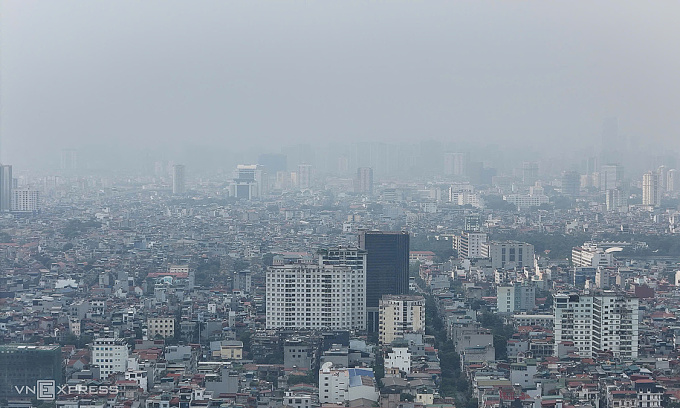Vehicles, industry, crop burning cause Hanoi pollution crisis
The Vietnamese capital has seen a significant worsening of pollution over the past decade.
According to data from the Ministry of Natural Resources and Environment, the issue becomes particularly severe between October and April, especially in areas with heavy traffic and industrial facilities.
The peak pollution hours are usually at 6–8 a.m. and 5–7 p.m.
A report on the country’s environment between 2016 and 2020 revealed that Hanoi’s PM2.5 levels were nearly double the national average. PM2.5 refers to particulate matter with a diameter of 2.5 micrometers or smaller. These microscopic particles are about 30 times smaller than the width of a human hair and can include dust, dirt, soot, smoke, or liquid droplets.
The sky in downtown Hanoi at noon on Nov. 18, 2024. Photo by Read/Pham Chieu |
In 2019 some 30.5% of the days in Hanoi were classified as having poor or very poor air quality based on the Air Quality Index.
While air quality improved during the Covid-19 pandemic (2020-2021) due to reduced activity, pollution has since returned and worsened.
So far this year Hanoi has experienced four significant pollution episodes, including three between January and April and one in early October.
City officials have identified five main contributors to air pollution: vehicle exhaust and dust, industrial production, domestic activities, biomass burning, and agricultural practices.
Transportation remains the largest contributor. In 2019, PM2.5 emissions surpassed 30,000 tons, with more than 50% coming from local sources.
Traffic and road dust accounted for 56% of this. Hanoi has 1.1 million cars and 6.9 million motorbikes, 70% of which are over a decade old and discharge huge quantities of emissions.
 |
Traffic is identified as the largest source of emissions in Hanoi. Photo by Read/Pham Chieu |
A study by the Hanoi University of Science and Technology showed that vehicle emissions, especially from gasoline and diesel engines, contribute 46% of ultrafine particles, while motorbikes alone account for over 90% of volatile organic compounds emitted by road traffic.
Following motorbikes as the worst polluters are heavy trucks, buses and light trucks.
Industrial activities are the second largest source of pollution.
Hanoi has 10 industrial zones, 1,300 craft villages and many factories in nearby provinces situated within a 50–100 km radius.
The worst polluters among them are thermal power plants in Hai Duong and Quang Ninh, cement factories in Hoa Binh and Ninh Binh, and fertilizer and chemical plants in Thai Nguyen and Phu Tho.
The burning of agricultural by-products accounts for 13% of the pollution.
The worst pollution occurs after the summer-autumn and winter-spring rice harvests, when, in outlying districts like Quoc Oai, My Duc and Chuong My, farmers burn rice straw in their fields.
Other sources such as construction, waste burning and residential activities contribute 10% of the pollution.
Weather intensifies pollution
Although HCMC has more sources of emissions, Hanoi suffers from worse pollution due to unfavorable weather conditions between October and April.
Significant temperature variations between day and night, high humidity, changes in wind direction and speed, and intense radiation limit the dispersion of pollutants, especially PM10 and PM2.5 fine dusts.
“These unfavorable weather conditions make air pollution in northern Vietnam, especially Hanoi, more severe compared to the central and southern regions or other months of the year,” Le Hoai Nam, deputy head of the ministry’s pollution control department, said.
Management challenges
Hoang Duong Tung, Chairman of the Vietnam Clean Air Network, pointed out that existing air quality management regulations are inadequate and fail to address sector-specific issues.
For instance, the growing concern over waste incineration was not anticipated earlier, he said.
A waste-to-energy plant near Hanoi now processes 4,000 tons daily, emitting millions of cubic meters of gas per hour, which requires strict monitoring, he said.
 |
A quarry where cement is exploited in Hoa Binh Province that borders Hanoi. Photo by Read/Gia Chinh |
Despite increased decentralization, local governments remain disengaged from air quality management, he said.
“Air pollution management is mostly handled at the central or provincial levels, while district authorities responsible for the pollution sources show little involvement.”
Many local authorities lack an understanding of their primary pollution sources, making it challenging to implement solutions, he added.


Comments are closed.